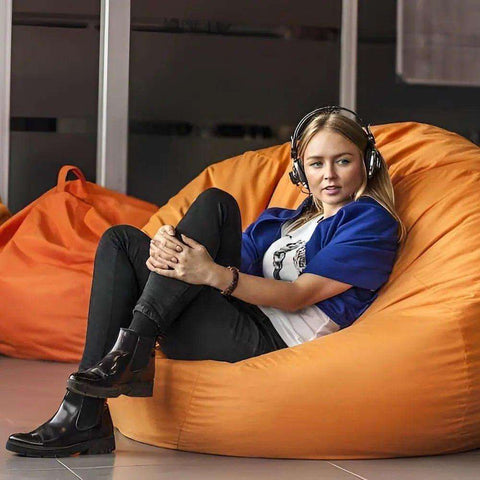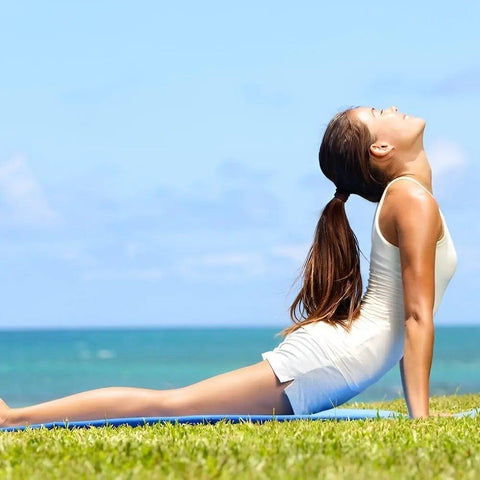Where were you in 1969? You might have been protesting a war. You might have been celebrating equal pay for women. Maybe you weren’t even born. Most likely, you weren’t attending the Paris Furniture Fair. The bean bag chair, however, did attend the Paris Furniture Fair on January 19, 1969. Initially called the Sacco, it didn’t take long before it was known as the bean bag chair. This nifty little chair was an icon of the 1970s and on the Christmas list of old and young alike. But similar to mood rings and go-go boots, the popularity of the bean bag chair faded away. Or did it? The bean bag chair turns 50 soon. It has evolved over the years, but it remains strong. Nowadays, bean bag chairs are not only found in family rooms, but also in other areas of the home. You can see them in office spaces and workplaces all over the world. Today, beanbag chairs are available in a wide range of styles and are designed to complement modern interiors.
Bean bags are also gaining popularity for home office use due to their ergonomic benefits. Beanbag chairs are also ideal for activities such as watching television, gaming, or simply relaxing. If you suffer from back pain or any other type of joint discomfort, consider incorporating an office beanbag into your workspace.
Beanbag chairs can now be found in various rooms, and the range of beanbag chairs available today caters to different preferences and needs, from children to adults. Do we know the answer to the question ‘are bean bags good for your back’? We’ve prepared a list of tips for ergonomic bean bag chair users at work. Read it and prepare to relax.
A Little History with Ergonomic Tips
Ergonomics is an ancient concept. Ancestors of modern humans, likely early humans, created tools designed to make work easier. Of course, they didn't use the word ergonomics, but they understood the concept of developing tools that fit the human body and the way it naturally moves. As civilisation advanced, inventors continued to value ergonomics. World War II and the military machines used during battle, especially aeroplane cockpits, employed ergonomics as a means of organising complex controls, allowing flight crews to better access and manage them. Ergonomics saved lives during the war. It helped pilots not crash planes. Fast forward to the modern office, where workers are given handouts with stretching exercises printed on them. People with certain physical conditions are even offered specially designed desks and chairs. We've heard so much about it over the last several years that ergonomics isn't the workplace buzzword it was a decade or so ago. Perhaps we take it for granted, but it remains relevant.
Ergonomic Bean Bag Chairs
Doctors recommend bean bag chairs for patients with back issues, and these chairs are often used to prevent other health-related problems. The filling used in bean bag chairs adapts to your sitting or lying position, adjusting to your posture. This relieves pressure on your muscles and helps alleviate pain. Imagine how relaxed a person feels when they sink into the comfort of a bean bag chair after hours of sitting. Bean bag chairs can be filled with polystyrene beads or foam, and the filling directly affects the chair's shape and support. The chair's shape is maintained by the quality of the fill and the thoughtful design, ensuring lasting comfort and proper support.
After the fill, a durable fabric and a soft outer cover contribute to the chair's longevity and comfort, making it both resilient and pleasant to the touch. These features work together to provide optimal comfort, achieving the perfect balance between softness and support for an experience that is super comfortable and delivers ultimate comfort.
People who work on computers for long hours suffer from backaches, joint aches and headaches. If you think about the structure of a typical office chair, you’ll understand why. Most office chairs are on wheels, or even worse, are uncomfortable, square-shaped, stationary pain machines. When you sit in these chairs, you twist your body every time you reach for something. Hence, backaches. You also have little control over the distance between you and your computer screen. Bring on the headaches and eye strain. Traditional office furniture often breaks most of the ergonomic rules. Bring on the bean bags!
Choosing the Right Chair
Selecting the ideal bean bag chair for your space begins with considering how you’ll use it. Are you dreaming of a cozy reading nook, a spot for watching TV, or a versatile seating option for simply relaxing? The purpose will help you decide on the perfect size and shape. For a home theatre or living room, a larger bean bag chair with ample space and a sturdy base is a great choice—especially if you want to accommodate multiple people or love sinking into cloud like comfort. In a kids' room or a smaller space, a compact bean bag is perfect for little ones or for tucking into a corner.
Pay close attention to the materials and bean bag filling. Premium fabrics and only the finest materials ensure unparalleled comfort and durability, even with frequent use. Look for a removable, machine-washable cover for easy cleaning—especially important in high-traffic areas or homes with children. Popular options, such as the Yogibo Lounger or the Trule Large Bean Bag Chair Mondo Faux Fur, offer a perfect blend of style, support, and unmatched comfort, making them a versatile addition to any room. Whether you’re outfitting a reading nook, living room, or home theatre, choosing the right bean bag chair means you’ll enjoy exceptional comfort and relaxed elegance every time you sit.
Setting Up Your Workspace
Creating a productive and inviting workspace with your bean bag chair is all about thoughtful placement and smart accessories. Start by positioning your bean bag in a spot with plenty of natural light and a comfortable temperature—near a window or in a quiet corner of the room works wonders. Consider the flow of the room and how your bag chair fits with other furniture; you want your workspace to feel open and accessible, not cramped.
Add a side table or a floor lamp nearby to keep essentials within reach and create a warm, welcoming atmosphere. If you’re using your bean bag chair for work or study, consider investing in ergonomic accessories like a lap desk or footrest to help reduce pressure points and support your posture. By arranging your bean bag thoughtfully on the floor and pairing it with the right furniture, you’ll create a space that’s both functional and comfortable, perfect for getting things done or simply relaxing.
1. Relax Your Back and Then Some
Let’s look at a few ergonomic tips, which will help maximise the experience of working from your chair. People who sit in front of a computer for extended periods often experience neck, shoulder, and back pain. Instead of the uncomfortable chair on wheels typically given to most office workers, try sitting in a giant bean bag chair for at least part of your screen time. A large bean-bag chair provides postural support. When you support the spine, you prevent the lower back from slumping. Your spine, in turn, supports your neck, which helps avoid shoulder slouching. Using a bean bag chair promotes relaxation, which can enhance productivity. The relaxed comfort of a bean bag chair, with its soft, body-contouring support, makes it ideal for both work and leisure. A straightforward remedy addresses three key problem areas.
2. Add a Back Pillow
Your lower back needs appropriate support. Bean bag chairs do provide lumbar support, but you can add extra support by placing a small pillow or a rolled-up towel between your back and the back of the chair.
3. Get Your Move On
No one should sit in a chair for prolonged periods. Even if your chair is a bean bag chair! Take a short break (10-20 seconds) every 10 minutes. Hands off the keys! Every 30-60 minutes, take a brief (2-5 minute) break. Get up and stretch. Take a walk around the building and get your blood pumping. Movement improves circulation, which markedly slows down when you're sitting for long periods. Movement is also the best self-remedy for creaking knees. It lubricates joints and prevents stiffness. If you're brave or don't care what others think, do a few stretches or march in place. Yes, right there in your workspace!
4. Roll Your Eyes
Working at a computer can put a strain on your eyes, especially if you stare at the screen for more than 20 minutes. You can avoid eye strain while working from your bean bag chair by rolling your eyes. Try these simple exercises:
-
Roll your eyes clockwise, then counterclockwise. Please don't overdo it on the eye rolls-a few times in each direction is excellent.
-
Cup hands lightly over eyes for 30 seconds, giving your eyes a break from irritating light from your computer screen and the fluorescent lighting found in so many offices. t
-
Look away from your computer and focus on objects on the floor or the wall. You can also focus on co-workers. They'll wonder what you're thinking.
These are the most natural ergonomic tips you can use because they don't require leaving your chair.
5. Wave Your Hands
You probably won't get carpal tunnel syndrome from working at a computer, but you could risk upper-extremity disorders associated with computer use. Try a few of these hand exercises from the comfort of your chair. Place your elbows on your desk. Using one hand, bend the other back toward your forearm. Hold briefly. Relax. Repeat on the opposite side. Fan your fingers out as far apart as you can. Hold. Clench fists. Release. Wave at coworkers. We're kidding, but why not be friendly?
6. Curl Your Toes
After a long day of sitting, do your feet look like stovepipes? Swollen feet look a bit disturbing, but you probably don't have a life-threatening disorder. However, swollen feet are a common occurrence for people who sit at a desk for hours at a time. Just like moving fingers and hands helps prevent problems with arms and shoulders, moving your feet can help prevent swollen feet and ankles. We have three ergonomic tips to prevent lower extremity issues. One can be done with your shoes on. One works better with shoes off. The third has nothing to do with moving your feet.
-
Rotate your foot at the ankle. Make slow, relaxed circles. Then, loop in reverse. Switch to the opposite foot and repeat. Unless you wear tall boots or high-top hiking shoes, you can leave your shoes on for this exercise.
-
For this exercise, flex your toes up, then curl them under your feet. Release and repeat. Toe curls work best with your shoes off. Be kind to coworkers and wear clean socks!
-
Put your feet up! Keep an ottoman in your workspace and use it when your feet and legs need some serious relaxation.
Your feet will thank you for these small efforts, but so will the rest of your body. The final ergonomic tip for people who enjoy office bean bags will help you view desk work from a different perspective.
7. Try a Lap Desk
In most online images, you see people working from bean bag chairs, resting their laptops or tablets on their knees. That’s not a great idea because it puts a strain on your wrists, forearms, and elbows. It’s okay if you only do it for a few minutes, but you won’t like the cramps and aches if you do it for hours. Avoid pain and stress on your upper extremities by using a beanbag desk. Similar to your chair, a lap desk allows a working setup that’s matched to your body. Bean bag chairs should provide strong back, neck, and head support. The Moon Pod is a great example of a compact, supportive bean bag chair designed for ergonomic comfort in small spaces. You customise the position of the counter. Have you ever tried customising the office furniture in your cubicle?
Maintenance and Upkeep
To keep your bean bag chair looking and feeling its best, a little regular care goes a long way. For everyday messes, spot cleaning the cover with cold water and a mild detergent will handle most spills. When it’s time for a deeper clean, unzip the removable cover and machine wash it in cold water—just be sure to check the care label for specific instructions. This makes it easy to keep your chair fresh, even with frequent use.
Don’t forget about the bean bag filling! Over time, the filling can settle, so give your bag chair a good fluff and re-arrange the filling to maintain its shape and plush comfort. If you notice your chair losing its support or looking a bit flat, it might be time to add more high-quality bean bag filling or replace the old fill. With these simple steps, your bean bag chair will continue to offer maximum comfort and style for years to come.
Overcoming Challenges of Working from Home
Staying focused and motivated while working from home can be tough, but the right setup makes all the difference. A bean bag chair is more than just a cozy seating option—it’s an ergonomically designed solution that supports your body and helps you sit upright, reducing back pain and fatigue. To boost productivity, pair your bean bag chair with a lap desk or footrest, creating a workspace that encourages good posture and keeps you comfortable throughout the day.
Establish a routine and set clear boundaries between work and personal time to avoid burnout. By dedicating a specific area for work—anchored by your bean bag chair—you’ll find it easier to stay on task and maintain a healthy work-life balance. With the perfect blend of comfort and function, your bag chair can help transform working from home into a more enjoyable and successful experience.
Enjoying Our Ergonomic Tips?
We hope you've enjoyed our ergonomic tips for those who work from their office bean bag chair. If you've not tried a bean bag, why not? Visit our blog for even more tips and fun articles about the many ways people enjoy using bean bag chairs. We offer a premium collection of indoor bean bag chairs that blend sophistication and style. To find the perfect bean bag for your office, visit our online bean bag shop.
Additional Resources for Ergonomic Support
If you’re eager to learn more about ergonomic support and creating a healthy workspace, there’s a wealth of resources available. Consulting with a healthcare professional or an ergonomics expert can provide personalised advice on choosing the right furniture and accessories for your needs. Online, you’ll find helpful articles, videos, and tutorials from organisations like the Ergonomics Society, the American Chiropractic Association, and OSHA, all offering guidance on posture, workspace setup, and stress reduction.
By leveraging these resources, you can create a workspace that not only looks great but also supports your well-being and productivity. Investing in ergonomic support and high-quality furniture—such as premium bean bag chairs—ensures your living space is both comfortable and conducive to ultimate relaxation and success.




